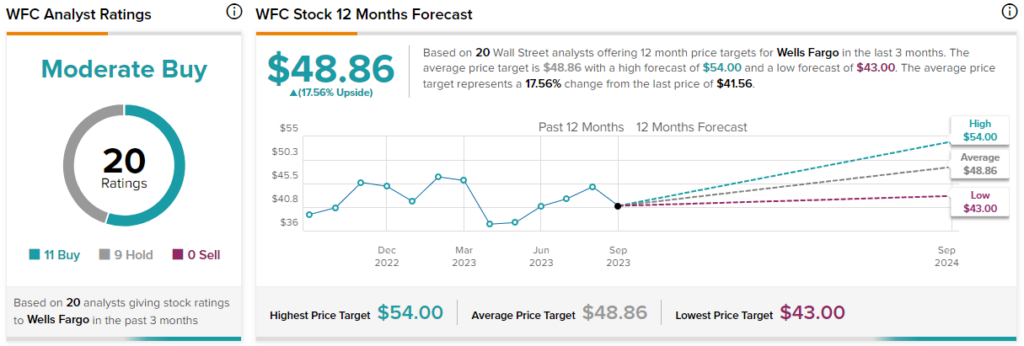Judging by the latest comments and action by the Federal Reserve, the economic forecast appears rather encouraging. However, investors may glean more information from big money moves, which appears to be the case for Wells Fargo (NYSE:WFC). Essentially, large block options trades appear to hedge against risk, which doesn’t spell confidence for the bank or the broader economy. As a result, I am slightly bearish on WFC stock.
Elevate Your Investing Strategy:
- Take advantage of TipRanks Premium at 50% off! Unlock powerful investing tools, advanced data, and expert analyst insights to help you invest with confidence.

Laying Out the Conflicting Narratives for WFC Stock
A pivotal factor in the investment discussion surrounding WFC is the broader trajectory of the U.S. economy. If the Fed achieves a soft landing as its policymakers anticipate, WFC and other related assets might appear as attractive investment opportunities. On the contrary, if the economy faces a hard landing, investors may find themselves in a position to reassess.
Recent data appears to lean toward a more optimistic viewpoint for WFC. Vince Condarcuri of TipRanks reported that the Federal Reserve has opted to keep interest rates unchanged, in line with widespread expectations.
Notably, Condarcuri provided insights into the persistent issue of consumer price growth. He mentioned, “The central bank’s board members and presidents weighed in on PCE inflation and now expect it to be 3.3% in 2023. For reference, they had forecast 3.2% in the previous report. However, Core PCE inflation projections decreased to 3.7% versus 3.9%.”
Additionally, Condarcuri observed that while inflation levels remain high, with an upward revision in GDP expectations, the chances of the economy slipping into a recession might be reduced.
This perspective, however, finds a challenge in earlier assessments of the economy. Marty Shtrubel, also from TipRanks, highlighted in May that renowned investor Paul Tudor Jones expressed concerns about an imminent recession, even suggesting it could materialize this autumn.
Jones’s apprehensions stem from the rapid accumulation of debt and the surge in asset prices in recent years, both of which he believes could catalyze an economic downturn.
Big Block Options Trades Raise Eyebrows
The dynamics of options trading frequently serve as a barometer for retail investors, providing insights into the movements of institutional money – often referred to as the smart money. Especially intriguing are the big block transactions, which involve significant premiums and are typically associated with institutional investors. For WFC stock, the emerging sentiment raises questions.
In the days leading up to the Federal Reserve’s announcement on monetary policy, significant players in the market exhibited a bullish stance on WFC stock. Notably, on September 14, options flow data highlighted the purchase of 1,503 contracts of the Sep 20 ’24 42.50 call, involving a premium transaction worth $814,500.
The subsequent trading day witnessed a separate but significant transaction. A trader pocketed a premium of $1.02 million upon selling (also known as writing) 3,001 contracts of the Jan 17 ’25 40.00 put. At the transaction’s inception, WFC stock was trading at $42.98, likely indicating a belief that the stock would maintain its position or perhaps appreciate further.
Yet, the narrative has since evolved. WFC stock currently trades at $41.57, casting doubt on the optimism surrounding the aforementioned put trade. Following the Fed’s announcement, a notable shift occurred — increased buying of puts and selling of calls by prominent traders.
It’s essential to interpret this data with caution. While it doesn’t conclusively demonstrate a bearish sentiment from large traders toward WFC stock, the transition from overarching optimism to a discernible increase in caution cannot be overlooked.
Volatility Curve Tells the Tale
The implied volatility (IV) curve for WFC stock options offers another layer of insight into the market’s sentiment. Serving as the market’s projection for potential movements in the price of the underlying stock, the curve reveals a nuanced story.
Interestingly, as the strike price increases, the IV demonstrates only a modest uptick. In stark contrast, when the strike price diminishes, the IV experiences a sharp rise. To put these dynamics into figures, the peak IV for out-of-money (OTM) calls is registered at 57%. Yet, for deep-in-the-money (ITM) puts, this metric jumps to an eye-catching 109%.
This divergence suggests that options traders might be gearing up for tail risk, essentially preparing for unforeseen, disruptive events that have a low probability but a potentially high impact.
The rationale for such hedging becomes clearer in the context of business dynamics. While the growth and consolidation of an enterprise is a gradual journey, its potential disintegration can be alarming.
Is WFC Stock a Buy, According to Analysts?
Turning to Wall Street, WFC stock has a Moderate Buy consensus rating based on 11 Buys, nine Holds, and zero Sell ratings. The average WFC stock price target is $48.86, implying 17.6% upside potential.

The Takeaway: WFC Stock Requires a Rethink
To be clear, no one should just jump on the bearish train just because options traders appear to be betting against Wells Fargo. Naturally, investors should conduct their own research before making a wager. That said, big block trades typically stem from either institutional investors or exceptionally wealthy traders. Since these parties have access to the best data, market participants should think twice before diving into WFC stock.
Lastly, the contrast between the Federal Reserve’s encouraging outlook and the concerns highlighted by renowned investor Paul Tudor Jones also warrants a cautious approach toward Wells Fargo.
















